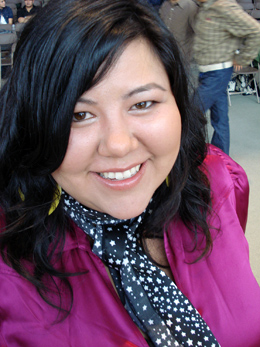BIO

Skeena Reece is 33 years old. Coming from the Tsimshian Territory, born of Metis/Cree and Tsimshian/Gitksan descent she has been working in the arts since 1996. Now, her multi-disciplinary practice includes: performance art, spoken word, humor, “sacred clowning”, writing, singing, songwriting, video art and arts administration. She travels well, packs lunch good and would be your pick to be ‘stranded on a deserted island’ with. Currently, she is a Board Member of the Native Youth Media Society (Redwire Magazine) and past Director of the Indigenous Media Arts Group (2005 - 2007). Also, she is the Founder of the Native Youth Artists Collective, which aims to incorporate in 2008. She was the Co-Director and Principle Actor of “Homestay” the movie in 2007 and is set to release her first self-produced music album in 2008. For more information visit: myspace.com/skeenareece or email (my first & last name) at hotmail.com
VIDEO DESCRIPTION
This is a video of Skeena Reece’s performance, ‘Sacred Clown’ - a collaboration between her and Jesse Scott (a multi-media artist who works with audio-videoscapes) for the experimental exhibition called Brief Encounters. This one was the sixth one. Brief Encounters is a project of the Tomorrow Collective in which they pair 12 different artists and give them two weeks to prepare a collaborative performance piece. The performance begins with pre-recorded video of Skeena saying, “I’m sorry, I’m really sorry, please forgive me.” She enters the room nude, painted with black and white stripes. Her hair is up in misshapen braids sticking out to the sides. She walks around the room whispering and makes her way to the stage. The video begins to jump around to different sequences and interacts with Skeena’s spoken word as Jesse performs live interactive video jockeying. Skeena finishes by saying, “purple is a healing color,” and wraps a cloth around herself. She exits through the audience whispering.
ARTIST STATEMENT
Skeena Reece’s voice is beautiful and important. Her perspective as a native woman who grew up in a small town and moved to the big city is not unique, but her life experiences are. She studied Media Arts at Emily Carr, but found her voice in Performance Art. With intention she uses her skills as a writer, a singer, a humorist, a Sacred Clown and a ‘backyard channeler’ to give the audience perspective on subjects relating to race, class, leadership, political landscapes, culture and love. As a performer, an arts administrator, and emerging curator she loves to engage audiences in a meaningful, tangible and straightforward way. Skeena will be the girl pacing in the hallway at an aboriginal economic development conference rehearsing roasts on aboriginal leaders, or making a modern potlatch of 600 people sigh from hearing about child abuse in her stand-up comedy routines, or excite elders watching her sing the blues on national television. Whether in an art gallery blocks from parliament or a gymnasium on a reserve, she takes Her space.
PERFORMANCE DESCRIPTION
‘The Sacred Clown,’ a collaborative performance between Skeena Reece and Jesse Scott, is based on the Sacred Clown of the Hopi Indians, a character that often says or does uncouth things to teach lessons. Skeena’s performance is also based on Raven The Trickster and Coyote The Trickster. The Raven is known for playing tricks on people, but is also revered as a wise entity. These characters were highly respected for the work they did in helping communities examine their values and beliefs, but today they are often found in institutions, no longer respected for the lessons they have to teach. Growing up hearing stories of the Raven Trickster spirit on the west coast of BC has informed Skeena’s humor. She invokes the spirit of the Trickster just to see what happens.
Skeena Reece wrote and performed for the video projection, as well as writing and directing her performance. Jesse Scott shot the video and performed with Skeena as the live video projectionist. ‘The Sacred Clown’ exemplifies ‘Skeena style,’ which is often improvisational, works from a preconceived concept, and uses some multi-media and/or other materials.
Watching this video requires the free Flash Player.

